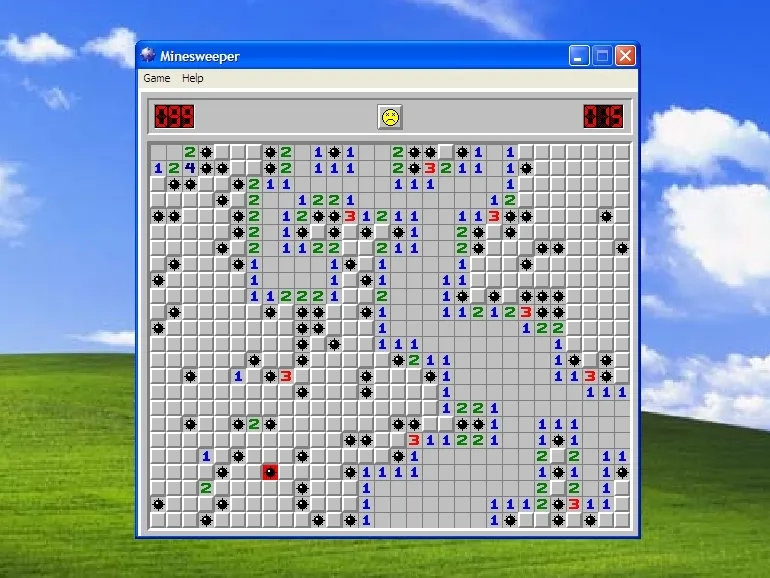The history of Minesweeper is quite surprising given the simplicity of the game itself. Known for its simple yet challenging mechanics, it became a staple on many office and household computers, particularly those running on Windows software. Yet, despite its widely spread fame and the many hours players all over the world spent trying to solve its puzzles, its origins still manage to baffle many with its unknowns.
The early days in the history of Minesweeper
History seems to have forgotten who created the first Minesweeper game, and when its first version came to light. Nevertheless, this did not discourage gaming historians from searching for its origins.
Minesweeper's roots can be traced back to the 1960s and 1970s, to the boom of logic and puzzle games, and to the interest and talent of early developers. In 1983, Ian Andrew, a developer who until then was more focused on pinball-type games, developed “Mined-Out” which is often considered the very first Minesweeper. Then, in 1985, “Relentless Logic” was released for MS-DOS, with the game displaying most of the dynamics and mechanics of the game we know today, even if its theme was different.
Nevertheless, the game would have to wait until 1992 to reach the world masses and become a major hit. Its inclusion in the software Windows 3.1 by Microsoft would change Minesweeper’s history. Interestingly, the developers of Microsoft’s game admit they borrowed the design and gameplay from a game other than “Mined-Out” or “Relentless Logic”, but they could not recall its name.
Rise to popularity with Windows
The version of Minesweeper that most people are familiar with first appeared in 1992 in Microsoft's Windows 3.1 software, as part of their entertainment suite. It was developed by Robert Donner and Curt Johnson.
There were two main reasons for this inclusion. On the one hand, office workers were looking for ways to improve their computer skills and Microsoft believed that an entertainment pack could help fill that gap. Through these games, the players could engage in a fun activity and keep their motivation levels high, while also practicing their mouse navigation skills, particularly right and left clicking.
On the other hand, although the Personal Computers era was already hovering over society, these were still highly associated with a professional setting. As such, Microsoft’s entertainment bundle had the second role of trying to dilute this perception by appealing to kids and adults in their free time. Their goal was to create a positive association that would motivate people to buy new PCs to have at home.
The strategy worked perfectly. From that moment on, the history of Minesweeper took a new turn and became indissociable from that of computers in general.
Gameplay and appeal
Minesweeper is a single-player puzzle game. The goal is to open all the cells of a rectangular board while being careful not to touch those that contain hidden mines. With a right-click, the players must place a flag on the cells they believe hide the mines. Clicking with the left button of the mouse will open the cells instead.
The players use clues in the form of numbers that indicate how many mines are adjacent to a square. The game ends in defeat if they open a cell hiding a mine, or in victory if they safely open all the empty cells on the board.
The simplicity of the rules, combined with the need for logic and occasionally luck, made it both accessible and challenging. This balance is a key factor in its widespread appeal.
Decline and revival
The history of Minesweeper takes an unpredicted turn with the release of Windows 8 in 2012. The journey of twenty years in which it entered millions of households and offices worldwide hand in hand with Microsoft’s software ended, with the game no longer coming pre-installed in the subsequent Windows versions. It was the end of an era.
Minesweeper was moved to the online store of the software company and remains available for download. The game did not fall from grace within Microsoft’s entertainment bundle. Instead, it was its popularity that dictated this move. The company was looking to promote its newly released online store and was trying to find a way to invite users to visit it.
It worked, but only partially. Many players felt annoyed by this move and started to look for alternatives elsewhere. Soon enough, Minesweeper was experiencing a revival in the form of mobile applications, browser games, and even as Easter eggs in other software.
Cultural impact and legacy
Over the years, Minesweeper has become more than just a computer game. It has been a skills-training tool, an excuse for procrastination, a brain teaser, and for some, a competitive challenge. The game has spawned numerous replicas, both offline and online, and its community of fans is yet to dwindle.
Minesweeper’s history also reflects the evolution of the digital age, and its impact goes beyond entertainment. It is a symbol of the era when personal computers were becoming a household norm. Whether for nostalgia, challenge, or just to pass the time, it remains a beloved classic in the gaming world.
As technology advances, games may come and go, but the legacy of Minesweeper endures as a testament to the fact that, sometimes, the simplest ideas can have the most lasting impact.

